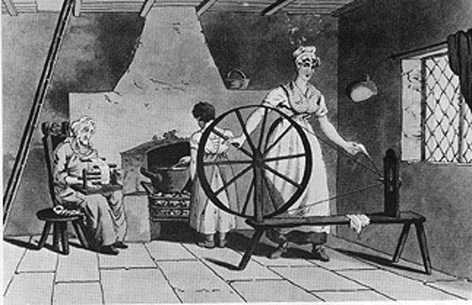Before factories as we would identify them, all manufacture of products like textiles was done at home and on a small scale. Work was confined to a cottage with everybody doing their bit. Work done at home – hence the “domestic” in the title – was slow and laborious. Daniel Defoe, of “Robinson Crusoe” fame -wrote about his journey through Yorkshire in about 1720 and described how he saw small cottages, small scale production and each family working for itself. However, not everything was done under one roof. Defoe noted that in Norfolk those employed in spinning worked elsewhere to those employed in weaving.
The process in the making of wool for clothes was as follows :
cleaning of the wool after it had been sheared from the sheep. carding of the wool – this was brushing it to separate the fibres. If a comb was used, this would be to get the fibres parallel. The cleaned and carded wool would then be spun by spinsters. This was frequently done by young girls. If these girls had not got married at a young age, it was believed that they would remain unmarried all their life – hence the term spinster today. The finished product of the spinsters was called yarn. the yarn would then be woven by a skilled weaver using a handloom. The finished product would then be sold to a clothier.
Each of these processes probably took place in separate cottages and spinning was seen as a job for women while weaving was seen as a man’s job.

The picture shows a typical domestic system home. The single room is dominated by a spinning wheel which is being worked by a young lady – the spinster. Food is being cooked in the same room. A ladder on the left of the picture will take the workers to their bedrooms once work for the day is finished and a window allows for light and ventilation. The amount of yarn produced in such a situation is clearly minimal.
If a worker did not work in his own home, he might work in a small workshop. Everything was done on a small scale. Even the coal mines – to fuel local cottages rather than send coal further afield – were small with shallow bell pits being the favoured type of mine as opposed to deep coal mining.
What was so good about the domestic system ?
the workers involved could work at their own speed while at home or near their own home. children working in the system were better treated in this system than they were to be in the factory system. As the women of a family usually worked at home, someone was always there to look after the children. conditions of work were better as windows could be open, people worked at their own speed and rested when they needed to. Meals could be taken when needed. as people worked for themselves they could take a pride in what they did. Tension in the work place was minimal as the family worked as a unit. the best home produced goods were of a very good quality – though this probably was not true at a general level.
However, the domestic system did have a number of major weaknesses in the growing industrial power that was the United Kingdom :
the production was very slow and the finished product was simply not enough to, in the case of textiles, cloth the fast growing population of the United Kingdom . A better and faster system of production was needed. the complete process of production was usually done in several cottages and time was lost as materials were taken from cottage to cottage as one stage progressed to the next. the power of water was being developed and small cottages could not possibly take advantage of this source of power. the image of nice quaint country cottages giving workers a quality lifestyle (if not well paid) simply is not a correct one. Defoe witnessed children as young as four working in the domestic system and the waste that gathered around country cottages which did not improve the standard ad quality of life for those who had to live near such waste.
With a growing population that needed feeding, clothing etc. a new way was needed to meet the demands that a growing population would make on Britain. This would lead to the new factories, large and deep coal mines, huge ship building ports and the growth of our industrial cities with all the problems they were to bring.
![]()